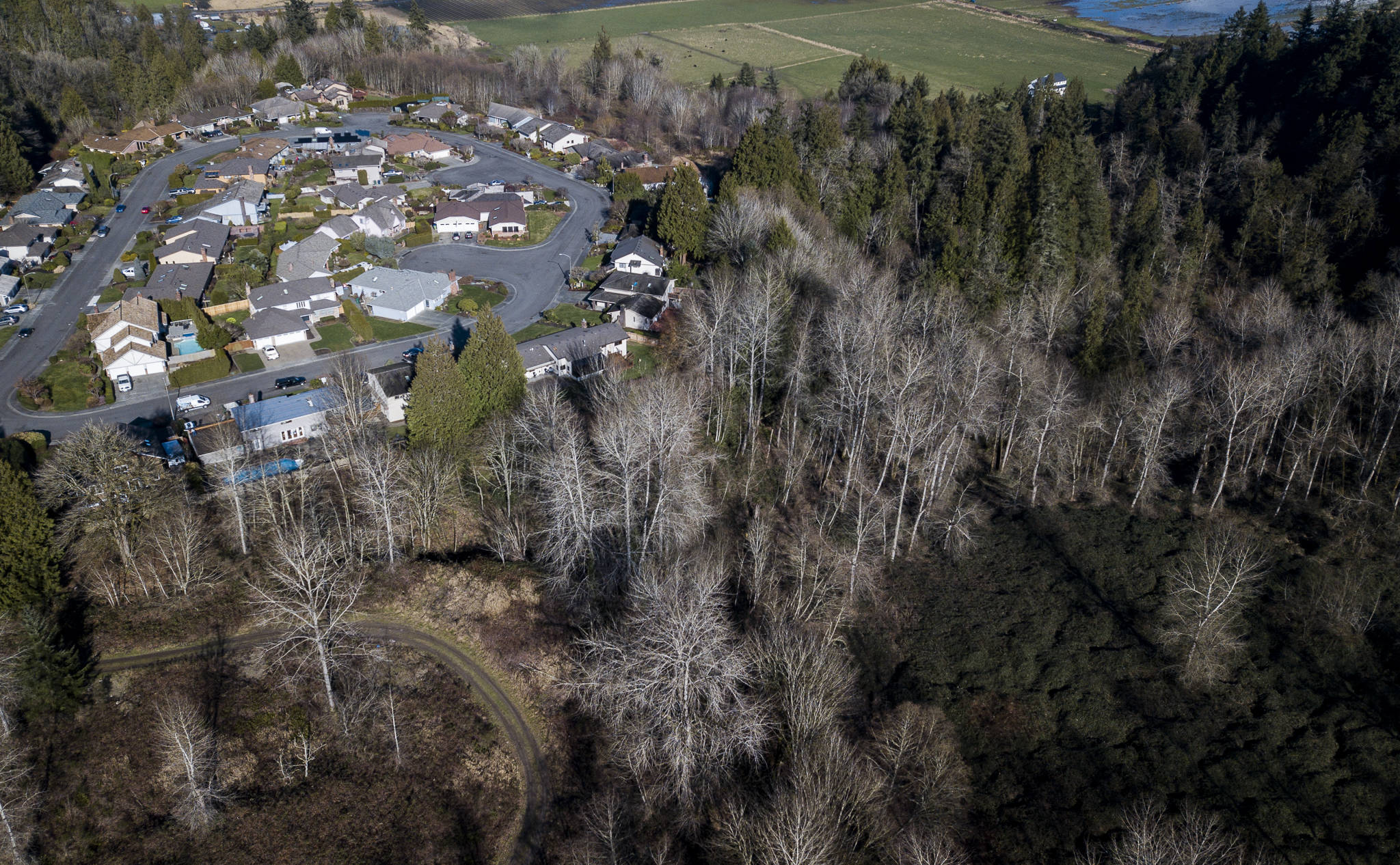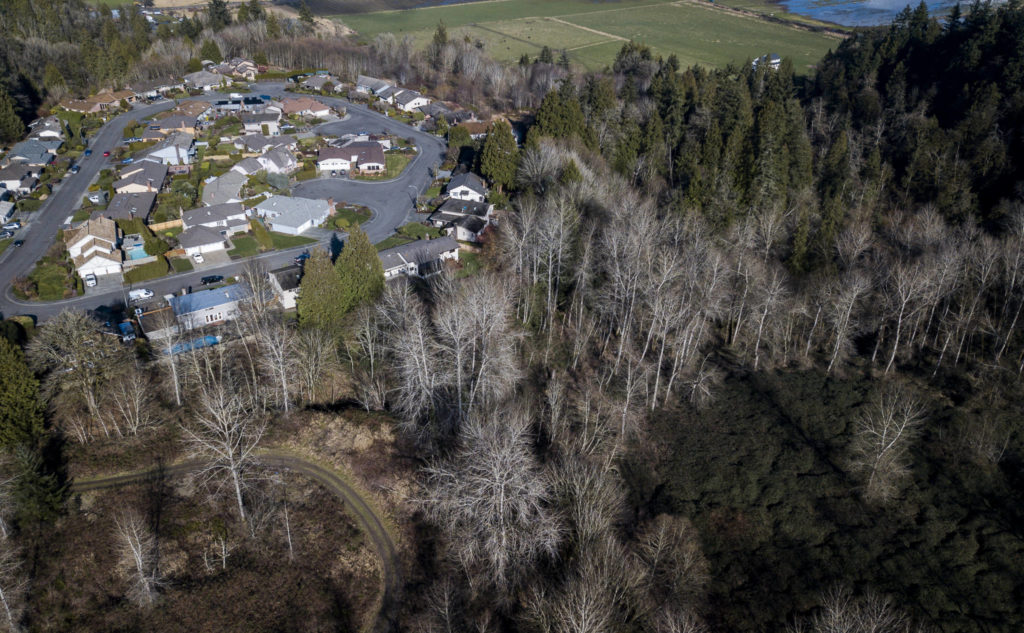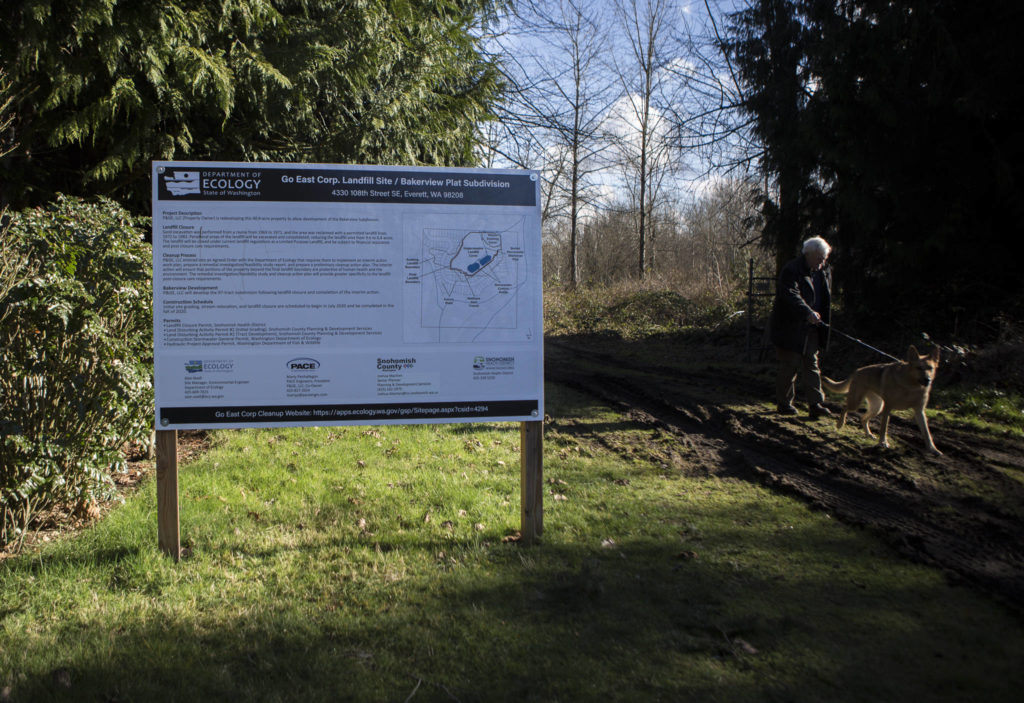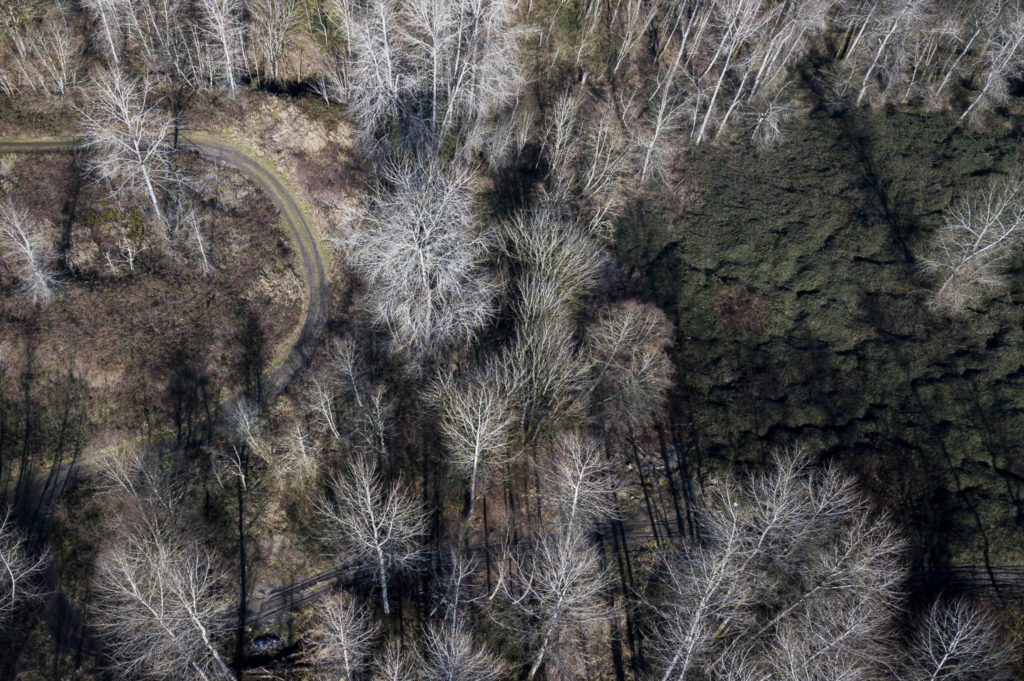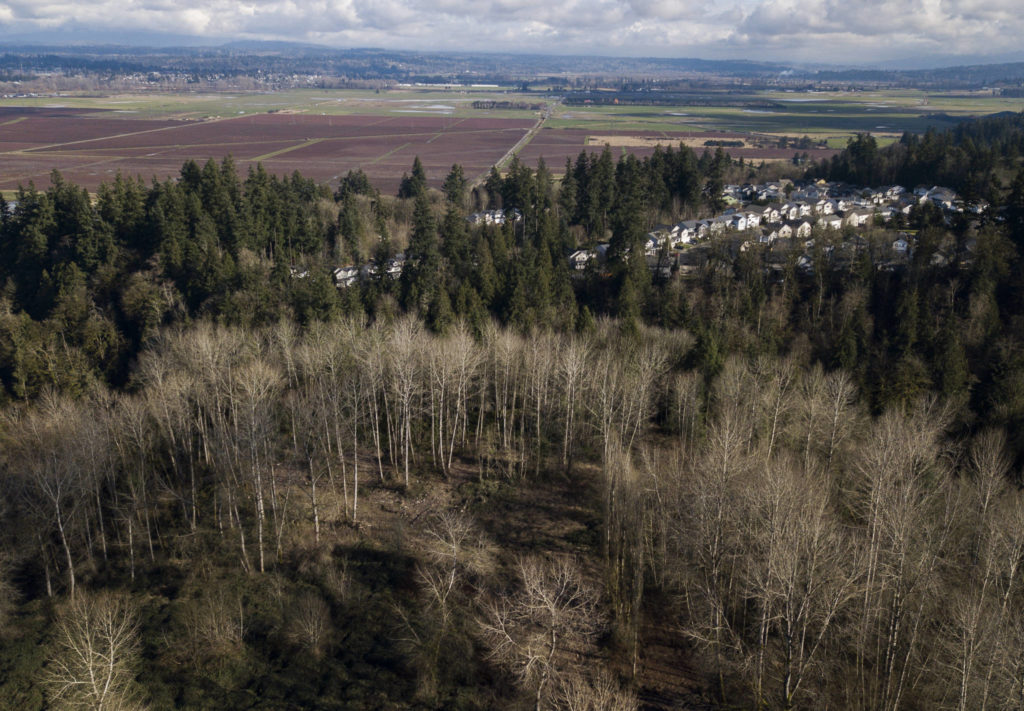SILVER LAKE — After a decade-long battle with surrounding neighborhoods, work to turn a former landfill into nearly 100 homes is scheduled to begin this week.
A 40-acre property east of Silver Lake and near the Snohomish River operated as a construction debris landfill from 1972 to 1983. Now a developer plans to condense the contaminated soil and create a new subdivision around it.
But two bordering neighborhoods argue the developer’s plan, OK’d by the Snohomish Health District and the state Department of Ecology, doesn’t go far enough to protect human and environmental health.
Houses from the ashes
The property’s first life was as a quarry in the early 1970s before Rekoway Inc. purchased it and opened a landfill for construction debris in 1972.
Two years later, Rekoway accepted about 200 cubic yards of baghouse dust — solid particulates from an industrial dust control system. The dust contained metallic material including magnesium, phosphate and aluminum, which quickly caught fire when exposed to a spark. Rekoway excavated the burning material, spread it on the ground and covered it with soil to extinguish the flames. Partially burned trees and stumps smoldered through 1977, when the Snohomish Health District suspended the landfill’s permit.
Go East Corp. purchased the Property in 1979 and requested reinstatement of the landfill permit. It wanted to fill the landfill area enough to level it out for future development. The Snohomish Health District gave the company a permit for a wood waste landfill in 1979. Go East stopped accepting waste in summer 1983, but another landfill fire broke out in October 1983 and wasn’t extinguished until January 1986.
Owner Gary East formed P&GE in May 2009 to begin developing the property into 97 homes as the Bakerview Subdivision.
Marty Penhallegon, founder of PACE Engineers and a partner in the redevelopment, said he never dreamed the project would take 11 years.
“I was envisioning maybe three,” he said. “Thanks to the neighbors that have appealed every appealable element possible it’s been drawn out.”
As the property lay dormant, Penhallegon said, it’s been used as public space. Paths have formed along streams. Neighbors walk dogs, kids play and the occasional homeless individual camps.
The Snohomish Health District oversees the landfill’s closure while the state Department of Ecology provides technical assistance and takes the lead on cleanup of any contamination released from the landfill. The health district does not have a geo-engineer on staff. It’s the applicant’s responsibility to hire one.
The Go East landfill never accepted human-generated trash, so it doesn’t produce as much methane gas as the contents break down, compared to municipal landfills like one along the Snohomish River in Everett.
New life for a landfill
When the landfill closed nearly 40 years ago, the owners covered it with 2 feet of soil. That’s all regulations required at the time. That sandy soil allowed methane gas generated by decaying wood to escape, said Alan Noell, site manager for the Department of Ecology.
P&GE will reduce the landfill’s footprint from 9.6 acres to 6.8 acres by excavating 2.8 acres from the perimeter and placing that fill in the middle. Then they’ll cover it with a layer of sandy soil, topped by an impermeable barrier. The barrier will trap any newly generated methane gas underneath. Two vents in the middle of the landfill and a trench around the perimeter will gather the trapped gas. Vent pipes will also be installed in the trench, and a collection system could potentially be retrofitted into pipes if methane levels rise above regulatory limits.
There currently aren’t any plans to collect the methane gas, Noell said. The former landfill doesn’t generate enough gas to reuse for power generation or to dispose by flaring, he said.
Houses built on the perimeter of the landfill will have vapor barriers and gas ventilation beneath their foundations as a precautionary measure. Once capped, the former landfill area will be open space, with a kids’ play area, Penhallegon said.
The plan “has been reviewed at the highest level,” he said.
Two stormwater ponds will collect runoff from roofs and streets in the new development and route it north across the landfill to join discharge from other subdivisions upstream of the Snohomish River.
In 2004, the Snohomish Health District sampled spots where groundwater seeps from the landfill area into Snohomish River tributaries. Those samples didn’t indicate pollution at high enough levels to warrant additional cleanup actions, Noell said.
Then in 2009, P&GE dug sampling wells above the landfill area. In theory, that area shouldn’t be impacted by landfill contaminants. But Ecology samples from those wells and surface water sampling showed metal particulates above state cleanup standards. Those metals are naturally occurring, Noell said, and could stem from conditions upstream of the landfill.
Ecology hasn’t recommended any further cleanup.
A long battle
Despite the project’s stamp of approval from Ecology and the health district, some neighboring communities don’t believe plans go far enough to protect human and environmental health.
Opponents argue there isn’t enough data to prove landfill contaminants won’t leach into the Snohomish River. They also don’t trust the developer’s methane collection system to prevent gas from leaking into houses built just a few feet from the landfill’s remnants.
Back in 2010, two neighborhood associations hired an environmental consulting firm to examine P&GE’s landfill closure plan. That’s when Pam Jenkins’ 11-year history with the Go East Landfill began.
Jenkins is a civil and environmental engineer who specializes in investigating contaminated sites like landfills. In the 1990s, she worked for the Department of Ecology to help write Model Toxics Control Act regulations.
In 2014, the two neighborhood associations appealed the landfill closure plan approved by the health district, arguing it didn’t cover air quality protections, citing as well noise and traffic concerns, among other issues.
The hearing examiner sided with the homeowners, who went on to appeal nearly every step along the project’s path to eventual approval. And after every appeal, the developer made slight changes to the landfill closure plan and the development plan.
“The scary thing is that if there had been no challenge, the landfill closure plan would have resulted in a very substandard closure which was not complete at all,” Jenkins said.
The final permits were approved in 2019. Both the Snohomish Health District and the state Department of Ecology believe the project satisfies legal parameters and is safe.
“Sixty-five test pit explorations have been completed to date. Sampling results for groundwater and surface water can be found in the closure plan,” health district officials wrote in an email. “After the landfill is closed, there will be ongoing groundwater, surface water and gas monitoring, until it is deemed safe to cease testing.”
But Jenkins said there’s just not enough data to confidently say the former landfill won’t affect human health or that it’s not sending pollution downstream to farms in the nearby Snohomish River valley.
P&GE tested groundwater once in 2009 on the property at four sites — three uphill from the landfill and one downhill. But the downhill well went dry before samples could be taken, Jenkins said, so it never got tested.
“It all comes down to a matter of contaminant concentration when you’re looking at if it’s going to be a danger to human health and the environment,” Jenkins said. “Without a down-gradient well, we don’t know the answer to that question.”
Penhallegon said all the water under the landfill flows out through seeps and springs to the hillside and is carried away as surface water. But Jenkins argues there’s no data showing the aquifer underneath doesn’t trickle down into the deeper aquifer associated with the Snohomish River.
“There is very possibly a connection between the two,” Jenkins said.
The Go East landfill doesn’t have a liner underneath it like newer landfills are required to.
‘It’s going to stay there’
Going forward, Penhallegon said, Ecology asked P&GE to dig an additional two samplings. All the wells and two surface water sites will be monitored quarterly.
Until 2019, the developer hadn’t sampled the landfill material itself. When they did, only the area that will be excavated for homes was tested.
The landfill was initially permitted to accept rock, mineral and concrete solid waste materials. When P&GE tested landfill material from 37 pits in the landfill area set for excavation, they found evidence of asphalt, tar, creosote and combustion remnants from the fires. Nothing reached levels of concern, Noell said.
Jenkins argues the amount of sampling data is insufficient to truly know what is in the landfill and the waste’s impact on the environment.
“Who cares what’s buried underneath or wherever,” Penhallegon said. “It’s going to stay there.”
But more information is always better, Jenkins said.
“And that’s not the story of this landfill,” she said.
Jenkins also worries the system to collect and monitor methane gas isn’t sufficient.
Methane is released as organic matter breaks down within a landfill. A high concentration of methane in an enclosed space can lead to suffocation and is flammable.
The Go East landfill produces much less of a typical methane than a municipal land waste accepting trash and recycling, like the Everett landfill underneath a future development along the Snohomish River.
P&GE measured methane production twice in 2009 and found levels well below what the Puget Sound Clean Air Agency considers acceptable.
But once the landfill is capped, Jenkins said, the methane’s concentration will increase.
The developer’s methane collection system is passive, as opposed to the active system used by developers in the Everett riverfront development. That collection process uses fans to suck methane out of the soil and blow it out above breathing level.
The P&GE collection system can be retrofitted with fans and blowers, Noell said, but Jenkins argues that plan puts future residents at risk.
“If there are measured amounts of methane in their detection probes over regulatory limits, then they will retrofit it,” she said. “There’s a possibility that human health will be impacted before they even know there’s a problem.”
But Penhallegon said retrofitting the pipes won’t be a difficult operation.
“There’ve been houses within 100 feet of this landfill since ’83 and there’s never been an issue,” he said.
Julie Chittenden is president of the homeowners association for King’s Ridge, a neighborhood directly west of the landfill. After years of contacting Ecology and the health district with concerns over various aspects of the project, she feels those comments fall on deaf ears.
Ecology’s public comment process last year did little to address neighbors’ questions, she said.
Ecology received 76 comments during the 52-day comment period, most of them requesting additional public meetings and voicing concerns over soil contamination. Ecology hosted a virtual public meeting, but many commenters said it didn’t have the same effect as an in-person meeting. Ecology’s responses to public comments weren’t released until Jan. 21, less than a month before work was scheduled to begin.
“It’s been a long hard fight,” Chittenden said. “And I don’t think it’s over yet.”
Julia-Grace Sanders: 425-339-3439; jgsanders@heraldnet.
Talk to us
> Give us your news tips.
> Send us a letter to the editor.
> More Herald contact information.
